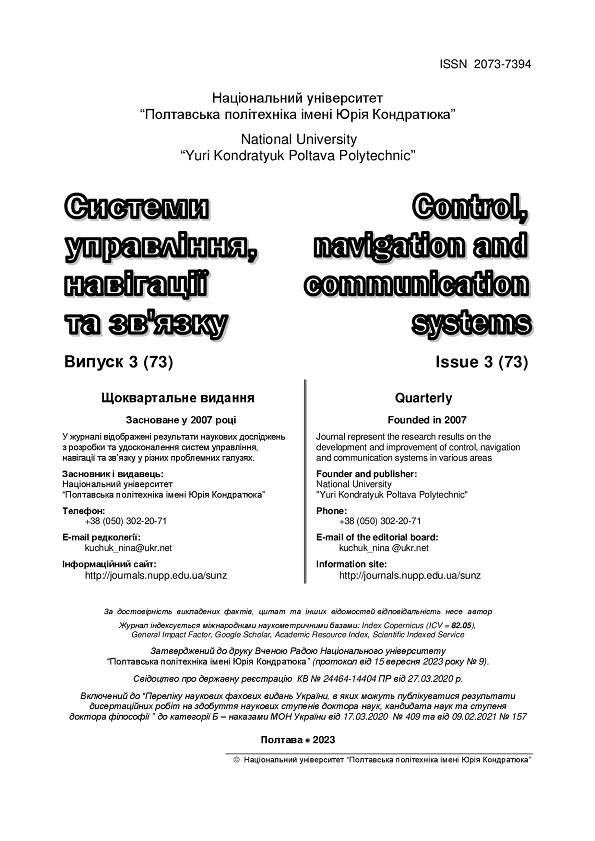ADAPTIVE DOUBLE NEO-FUZZY NEURON AND ITS COMBINED LEARNING
DOI:
https://doi.org/10.26906/SUNZ.2023.3.070Keywords:
fast data classification, online classification, fuzzy classification, short sample, neo-fuzzy neuron, combined learning IAbstract
The subject of the study in the article is the process of data classification under conditions of fuzziness and a limited volume of training sample. The goal is to enhance the double neo-fuzzy neuron within the framework of solving the data classification task with constraints on the training sample volume, processing time, as well as fuzziness and nonstationarity of input data. The tasks include improving the double neo-fuzzy neuron to enhance the system's approximation properties and developing a combined system learning method to ensure fast performance in an online mode. The approaches used are lazy learning, supervised learning, and self-learning. The following results have been obtained: the double neo-fuzzy neuron has been modified by introducing a compressive activation function at the output, creating conditions for building a neo-fuzzy network capable of adapting to non-stationary input data in an online mode and avoiding the vanishing gradient problem. Conclusion. A combined learning method for the double neo-fuzzy neuron has been proposed, involving parallel utilization of lazy learning, supervised learning, and self-learning with the "Winner Takes All" rule, followed by automatic formation of membership functions, enabling fast online classification in the presence of outliers in the input data.Downloads
References
Aggarwal CC (2018) Neural networks and deep learning: a textbook. Springer, Cham, Switzerland
Bengio Y, Cun YL, Hinton G (2015) Deep learning. Nature 521:436–444
Goodfellow I, Bengio Y, Courville A (2016) Deep Learning. MIT Press
Cybenko G (1989) Approximation by superpositions of a sigmoidal function. Math Control Signal Systems 2:303–314. https://doi.org/10.1007/BF02551274
Bodyanskiy YV, Tyshchenko OK (2020) A hybrid cascade neural network with ensembles of extended neo-fuzzy neurons and its deep learning. Advances in Intelligent Systems and Computing 945:164–174
Yamakawa J, Uchino E, Miki J, Kusanagi H (1992) A neo-fuzzy neuron and its application to system identification and prediction of the system behavior. In: Proceedings of the 2nd International Conference on Fuzzy Logic & Neural Networks. Iizuka, Japan
Miki T (1999) Analog Implementation of Neo-Fuzzy Neuron and Its On-board Learning
Zurita D, Delgado M, Carino JA, et al (2016) Industrial Time Series Modelling by Means of the Neo-Fuzzy Neuron. IEEE Access 4:6151–6160. https://doi.org/10.1109/ACCESS.2016.2611649
Bodyanskiy YV, Kokshenev I, Kolodyazhniy V (2003) An adaptive learning algorithm for a neo fuzzy neuron. In: Wagenknecht M, Hampel R (eds) Proceedings of the 3rd Conference of the European Society for Fuzzy Logic and Technology, Zittau, Germany, September 10-12, 2003. University of Applied Sciences at Zittau/Görlitz, Germany, pp 375–379
Perfilieva I (2006) Fuzzy transforms: Theory and applications. Fuzzy Sets and Systems 157:993–1023. https://doi.org/10.1016/j.fss.2005.11.012
Bodyanskiy Dr.-Ing. habil. Y, Gorshkov M.Sc. Y, Kolodyazhniy Dr.-Ing. V, et al (2007) Evolving network based on double neo-fuzzy neurons. Computer science meets automation: 52 IWK, Internationales Wissenschaftliches Kolloquium ; proceedings ; 10 - 13 September 2007; Volume I 52, 2007, Vol. 1:35–40
Hu Z, Bodyanskiy YV, Tyshchenko OK, Samitova VO (2017) Fuzzy clustering data given on the ordinal scale based on membership and likelihood functions sharing. International Journal of Intelligent Systems and Applications 9:1–9
Kaczmarz S (1993) Approximate solution of systems of linear equations. International Journal of Control 57:1269–1271. https://doi.org/10.1080/00207179308934446
Widrow B, Hoff ME (1960) Adaptive Switching Circuits. IRE WESCON Convention Record
Bodyanskiy Y, Kolodyazhniy V, Stephan A (2001) An Adaptive Learning Algorithm for a Neuro-fuzzy Network. Computational Intelligence Theory and Applications Fuzzy Days 2206:68–75
Zahirniak DR, Chapman R, Rogers SK, et al (1990) Pattern recognition using radial basis function network. Aerospace Application of Artificial Intelligence 249–260




